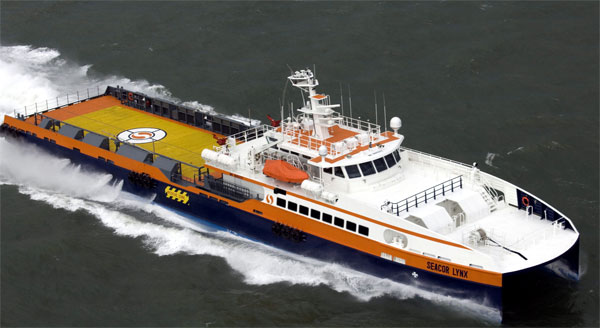Capt. Ron Rainey has driven high-speed cats for Seacor Marine in Angola, the Congo and the Caspian Sea. But as he takes Seacor Lynx down the Houma Navigation Canal for sea trials in the Gulf of Mexico, it feels like crew boat heaven.
The 192-by-41-foot speedster is the third CrewZer class cat designed by the Australian firm Incat Crowther and built for Seacor by Gulf Craft, which has set a high standard for aluminum crew boats. It’s the first boat out of Gulf Craft’s new yard in Franklin, La.
Rainey brought out the first of the cats, Seacor Cheetah, in January 2008. After two years on the bridge in Angola and the Congo, he transferred to the second, Seacor Cougar, working out of Baku, Azerbaijan.
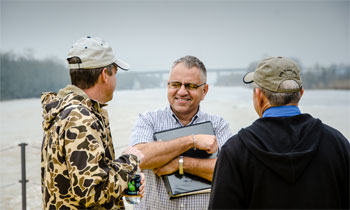 |
|
Brian Gauvin photo |
|
Some of the key players in the team behind the new crew boat: from left, Kevin Tibbs, president of Gulf Craft; Joe McCall, project manager for Seacor Marine, and Gippy Lacoste, yard supervisor for Gulf Craft’s new facility in Franklin, La. |
“I’ve been connected to the two boats for the past five years, and I love it,” said Rainey. “Now I’m bringing out the Lynx.” A fourth cat, Seacor Leopard, is taking shape for an early fall delivery.
Lynx can seat 150 passengers in first-class-style seats facing three 42-inch flat-screen televisions in a passenger cabin insulated against engine room noise and vibration. The aft deck has 2,810 square feet of clear cargo space with a capacity of 150 long tons rated at 615 pounds per square foot.
Seacor’s project manager is Joe McCall, who worked with his father, Norman McCall, at McCall Boat Rentals until it became part of Seacor Marine. “When we merged with Seacor in 1996 we brought 48 boats with us,” said McCall.
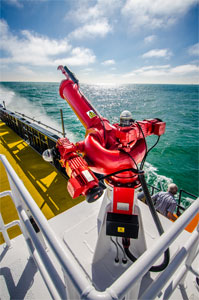 |
|
Brian Gauvin photo |
|
The FFS 1200 fire monitors are mounted port and starboard just aft of the bridge. |
The main impetus for the evolution of the crew boat was the development of deepwater oil exploration in the Gulf of Mexico, Africa and Brazil. The McCalls had pioneered a hybrid vessel that combined more passenger space with an aft-deck cargo capacity comparable with that offered by a small offshore supply vessel.
Their original boats were monohulls capable of 25 to 30 knots or faster. The CrewZer class is considerably faster; top speed is 42 knots. The passenger and cargo capacity make the high-speed cats cost-competitive with helicopter crew transport, especially overseas, where the custom is to transport crews by boat rather than chopper.
Seacor’s catamarans not only travel fast, they look fast, with a sci-fi edge.
 |
“These new ones are basically the same as the Cheetah and Cougar but are a little bit bigger and faster,” said McCall. “We added 11 feet to the length and four feet of beam to the Lynx and Leopard. And the bigger jets and higher-horsepower MTUs make the boat faster and more efficient.”
On Lynx and Leopard, the superstructure is 20 feet farther aft than on the first two cats. Rainey, the captain, said this makes the ride more comfortable for the passengers: “It’s back where the boat is more buoyant, so it will improve the pitch.” Passenger and crew comfort are also improved by a ride control system from Maritime Dynamics that dampens the effect of roll and yaw.
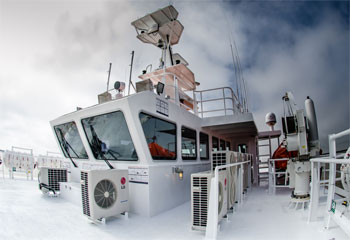 |
|
Brian Gauvin photo |
|
The aft bridge compartment is separated from the main bridge console by a bulkhead to comply with DP-3 regulations. |
The superstructure’s profile was lowered by eliminating the crew deck and moving the staterooms to the starboard pontoon. The port pontoon houses the galley and mess.
Eliminating the crew deck brought the vessel’s weight down to 497 gross tons, just under the 500-ton mark. Gross tonnage, not to be confused with gross registered tonnage, is based on the molded volume of all enclosed spaces on a vessel. The gross tonnage of a vessel determines the set of regulations a vessel must comply with regarding manning, safety, certain fees and port dues.
As a supply vessel, the demands on Lynx for precise station keeping at a rig over extended periods of time far exceed those of a crew boat on a crew change or dropping off technicians. It was inevitable that crew/supply vessels would follow OSVs and adopt dynamic positioning while working near a rig.
Kongsberg supplied the sophisticated DP systems for all four of Seacor’s CrewZer vessels. Seacor Cheetah and Cougar were the first DP-2 crew boats in the world, and Seacor Lynx is the first DP-3 crew boat.
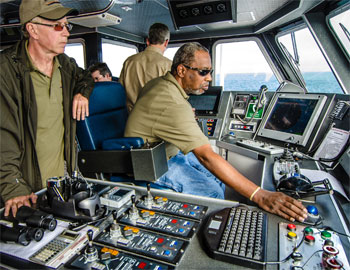 |
|
Brian Gauvin photo |
|
Capt. Ron Rainey (left) and Capt. Herman Alexander at the main console. |
“DP-3 is a big deal for us,” said McCall. “We are marketing autonomy, redundancy and safety with the DP-3, and improved safety and comfort of our passengers. With DP-3 we can have two fail and still maintain on station with the third. One DP control station is in the forward bridge console and two are at the aft console in a completely isolated aft station separated by an A60 bulkhead, as required of ABS DP-3 certification.”
The need for quick response to fires and other emergencies from vessels at or near remote rigs is a modern reality. Lynx is equipped with two FFS fire pumps powered by the two inboard main engines, producing 10,600 gallons per minute of sea water to two FFS deck-mounted fire monitors. “As well as fast supply boats, we’re marketing these boats as fast-response vessels for emergencies,” said McCall.
As distances increase between deepwater rigs and support facilities, so does the need for self-sufficiency in support vessels. To that end, Lynx carries an Aqua Matic watermaker capable of producing 1,800 gallons per day and two Headhunter water treatment units for treating gray water and black water. The vessel also has a dispersant system for oil spill cleanup and a Fast RSQ six-person rescue boat.
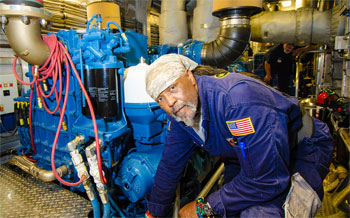 |
| Brian Gauvin photo |
|
Chief Engineer Allen Townsend, who has 30 years with Seacor, in the engine room. |
“The boats have great autonomy with the watermaker and treatment plant and firefighting capability, and all the redundancy that we get with the two-hull system,” said McCall. With each main engine power train and a retractable Thrustmaster 200-hp, azimuthing bow thruster located in separate pontoons, DP-3, and reversing Hamilton waterjets, Lynx could suffer a propulsion or thruster failure in one pontoon and still remain on station if necessary. “The boat is really two separate ships,” said McCall.
The vessel’s service speed, with 120 tons of deadweight, is 40 knots. Propulsion comes from four 3,860-hp MTU 16V 4000 M73L Tier 2 diesels with Twin Disc MGX-62000 SC gears at a 2.49:1 reduction ratio, driving Hamilton HM810 waterjets. Two Cummins QSM11 DM LTAC Tier-2 gensets provide 290 kW each.
“I use the thrusters on DP watch on station,” said Rainey. “But with these boats I don’t use the bow thrusters for any conventional boat handling. They handle phenomenally just using the jets.
“These boats are a really safe working platform when you’re on station. The roll is minimal so you’re just dealing with pitch. The Cheetah was doing so well on the Congo River that they used us instead of the supply boats most of the time.”

